Could Trump’s Tariffs Lead to a Rate Cut Down Under? Let’s Talk Global Ripples & Local Relief!
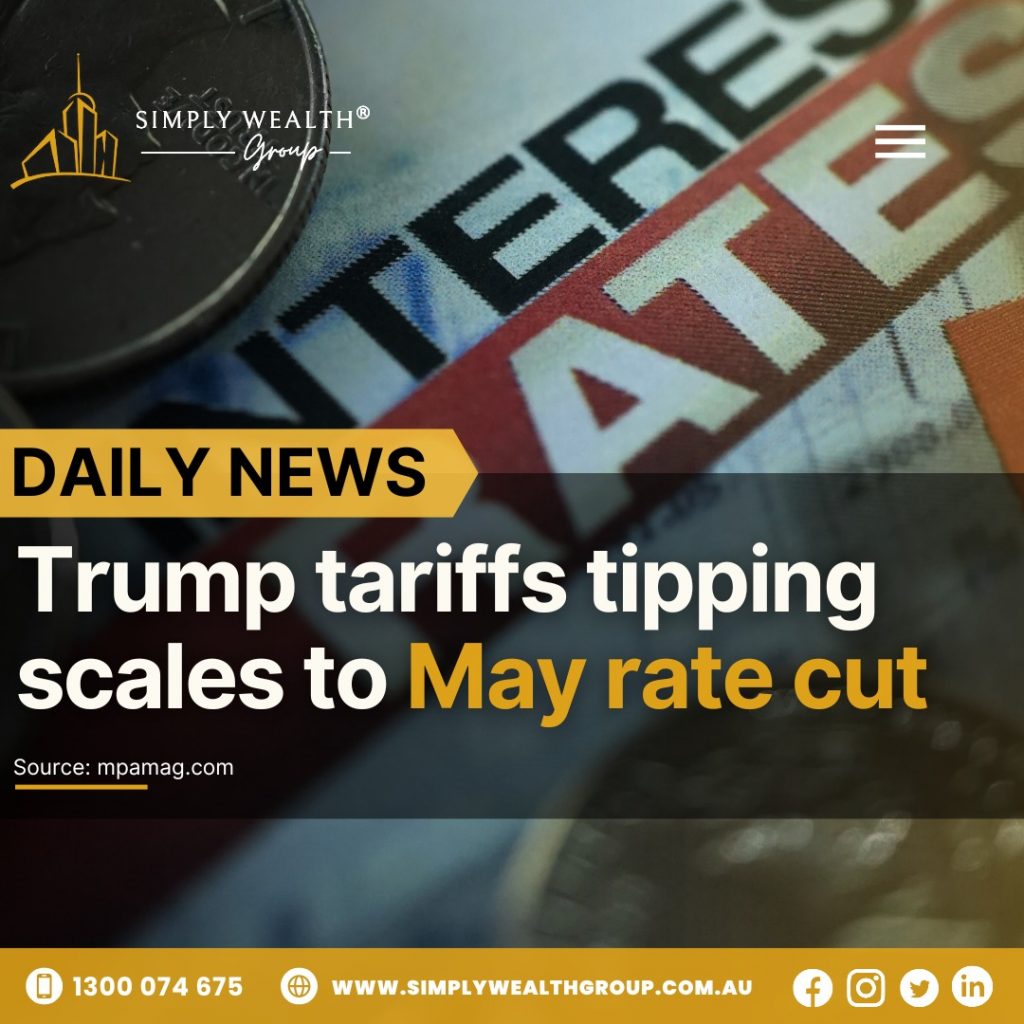
Could Trump’s Tariffs Lead to a Rate Cut Down Under? Let’s Talk Global Ripples and Local Relief In today’s interconnected world, decisions made in one country can have a significant ripple effect across the globe. A striking example of this is unfolding as former U.S. President Donald Trump re-enters the global economic spotlight with a bold tariff proposal. While the move is primarily targeted at addressing trade imbalances in the U.S., its potential consequences are already reaching Australian shores—especially in the realm of interest rates and property finance. So, how could American trade policy lead to a rate cut by the Reserve Bank of Australia (RBA)? The answer lies in the way global financial markets react to uncertainty—and how central banks respond to keep their economies stable. What’s Behind the Tariff Talk? Donald Trump’s tariff proposal is designed to curb imports into the United States, particularly from countries like China. If enacted, these tariffs would increase the cost of imported goods, potentially leading to higher inflation in the U.S. and slower economic growth globally. Historically, aggressive trade policies like these have resulted in supply chain disruptions, reduced investor confidence, and slower international trade—an environment where central banks tend to adopt more accommodative monetary policies. For Australia, this global uncertainty is especially relevant. As a trade-reliant nation with deep economic ties to both China and the United States, any tension between the two superpowers can create pressure on Australia’s economy, impacting consumer sentiment, export flows, and market stability. How It Affects Australian Interest Rates The RBA closely monitors global conditions when making decisions about the official cash rate. If global growth weakens due to rising trade barriers, the RBA may step in to support domestic economic activity through a rate cut. Lowering interest rates would not only cushion households against economic turbulence but also stimulate investment and spending at a time of global slowdown. With inflation in Australia already easing in early 2025 and signs pointing to a cooling economy, Trump’s trade agenda could be the tipping point that accelerates a rate cut decision as early as May. What It Means for Borrowers and Homeowners For mortgage holders, a rate cut would come as welcome relief. 🏡 Lower interest rates reduce monthly repayments, easing financial pressure for millions of Australians. This is especially significant given the recent years of rate hikes, which have stretched household budgets and slowed property market activity. Buyers—particularly first-home buyers—stand to benefit as well. 💰 Lower borrowing costs mean increased loan eligibility and improved purchasing power. For many who have been waiting on the sidelines, this may be the signal to jump back into the market. Meanwhile, investors may find renewed motivation to grow their portfolios. With property values showing signs of stabilisation, a reduction in interest rates could drive demand higher once again, especially in high-growth suburbs where affordability and rental yields align. What This Could Mean for the Property Market If the RBA does decide to cut rates in May, we may witness a return of positive momentum in the housing sector. 📈 Increased buyer competition could lead to moderate price growth, while improved affordability may attract a new wave of entrants into the market. Developers and builders could also benefit, as the prospect of easier financing may help revive new housing projects, especially in growing outer suburbs. However, it’s essential to approach this opportunity with strategy. A global rate cut environment can increase volatility across asset classes, and property buyers should still weigh long-term growth potential, rental yield, and location before making decisions. In Summary The potential for a May rate cut in Australia is gaining traction, and Trump’s proposed tariffs may play an unexpected role in that outcome. 🌐 While the primary battle is being fought on the global stage, the consequences could be felt directly in Australian households, in the form of lower interest rates, improved borrowing conditions, and renewed confidence in the property sector. Whether you’re already a homeowner, looking to invest, or preparing to buy your first property, staying informed about these international developments is key. Global politics might seem distant, but their effects could shape the most important financial decisions you’ll make this year. 📖 Want to understand the full scope of these economic shifts? Read the full article: https://tinyurl.com/ph8kwuk9 📞 For tailored advice on how to navigate the current market, call us at 1300 074 675🌐 Explore more: simplywealthgroup.com.au📱 Follow @SimplyWealthGroup for expert insights and property market updates
Homeowners Find Stability Amid Market Shifts in 2025
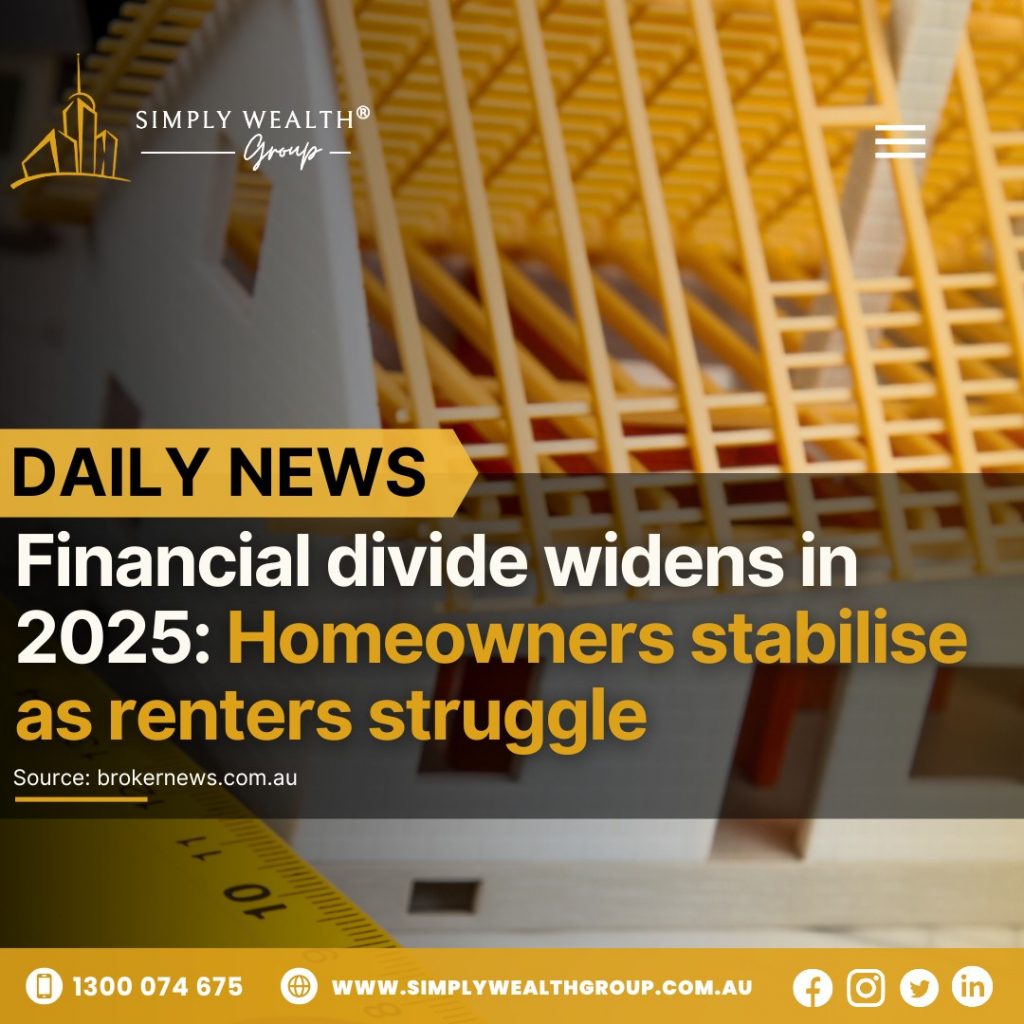
Homeowners Find Stability Amid Market Shifts in 2025 Australia’s property market is no stranger to change, and 2025 has proven to be yet another transformative year. While economic fluctuations continue to influence the broader housing landscape, homeowners are increasingly finding a sense of stability. This shift is being fueled by a combination of steady property values, eased interest rate expectations, and supportive government policies. For many, this environment represents an opportunity to consolidate gains, plan for future investments, and embrace homeownership as a long-term wealth-building strategy. A Calmer Economic Outlook Is Bringing Mortgage Relief After a period of interest rate hikes aimed at curbing inflation, signs of economic cooling have prompted more optimistic forecasts. The Reserve Bank of Australia (RBA) has indicated a possible pause—or even a cut—in interest rates in the coming months. This shift in sentiment is already translating into reduced mortgage stress for existing homeowners. Many are now breathing easier, with repayments becoming more manageable and refinancing options improving. For those who locked in higher rates during the peak of economic tightening, the current trajectory offers a chance to reassess and potentially refinance at more favorable terms. This is particularly welcome news for families and individuals who weathered the recent storm of rising living costs. With mortgage repayments becoming less burdensome, household budgets are beginning to stabilize. Home Equity Gains Offer a Strategic Financial Advantage One of the most significant benefits of owning property during this period has been the consistent rise in home equity. Even in a market where price growth has moderated, the long-term appreciation of property values has allowed many homeowners to build substantial equity. This accumulated wealth can be strategically used for a range of purposes—whether it’s upgrading to a larger home, investing in additional properties, or funding renovations that further increase a property’s value. Homeowners with strong equity positions are now in a unique place of financial flexibility. Many are choosing to leverage this advantage by expanding their property portfolios, while others are using the stability as a foundation for retirement planning or children’s education funding. The key takeaway? Property ownership continues to serve as a reliable pathway toward long-term financial security. Government Support Remains a Pillar of Stability In addition to favorable market dynamics, government incentives and support schemes continue to bolster homeownership across Australia. Initiatives such as the First Home Guarantee, shared equity programs, and various state-based grants are helping first-home buyers enter the market with lower upfront costs and more confidence. These policies have not only made homeownership more accessible but have also contributed to the overall resilience of the market. By supporting both new buyers and existing owners, the government is reinforcing the notion that property remains a cornerstone of financial wellbeing for Australians. The Rental Market Paints a Different Picture While homeowners are enjoying a period of relative calm, the rental market continues to experience pressure. Low vacancy rates, rising rental costs, and high demand have made renting increasingly difficult for many Australians. This divergence between ownership and renting is further motivating renters to explore pathways into homeownership—particularly as the cost of renting approaches, and in some cases exceeds, monthly mortgage payments. For those who have been sitting on the fence, the current conditions serve as a clear signal: now may be the ideal time to begin planning your move from renter to homeowner. With the right guidance and a solid financial strategy, stepping onto the property ladder is becoming more achievable than it may have seemed just a year ago. Why Now Is the Time to Act In times of uncertainty, stability becomes even more valuable. For homeowners, 2025 is shaping up to be a year of consolidation, opportunity, and renewed confidence. For aspiring buyers, it represents a unique window where affordability, incentives, and favorable borrowing conditions align. If you’ve been thinking about buying your first home, upgrading, or building a property portfolio, now is the time to act. The market is offering a rare combination of calm and opportunity—conditions that don’t always come around. 📖 Want to understand more? Read the full article here 📞 Speak with an expert: Call us at 1300 074 675🌐 Visit: simplywealthgroup.com.au📱 Stay informed: Follow us on Instagram and Facebook @SimplyWealthGroup
Hopes for an RBA Rate Cut in May Rise as Inflation Eases – REIQ Reports!
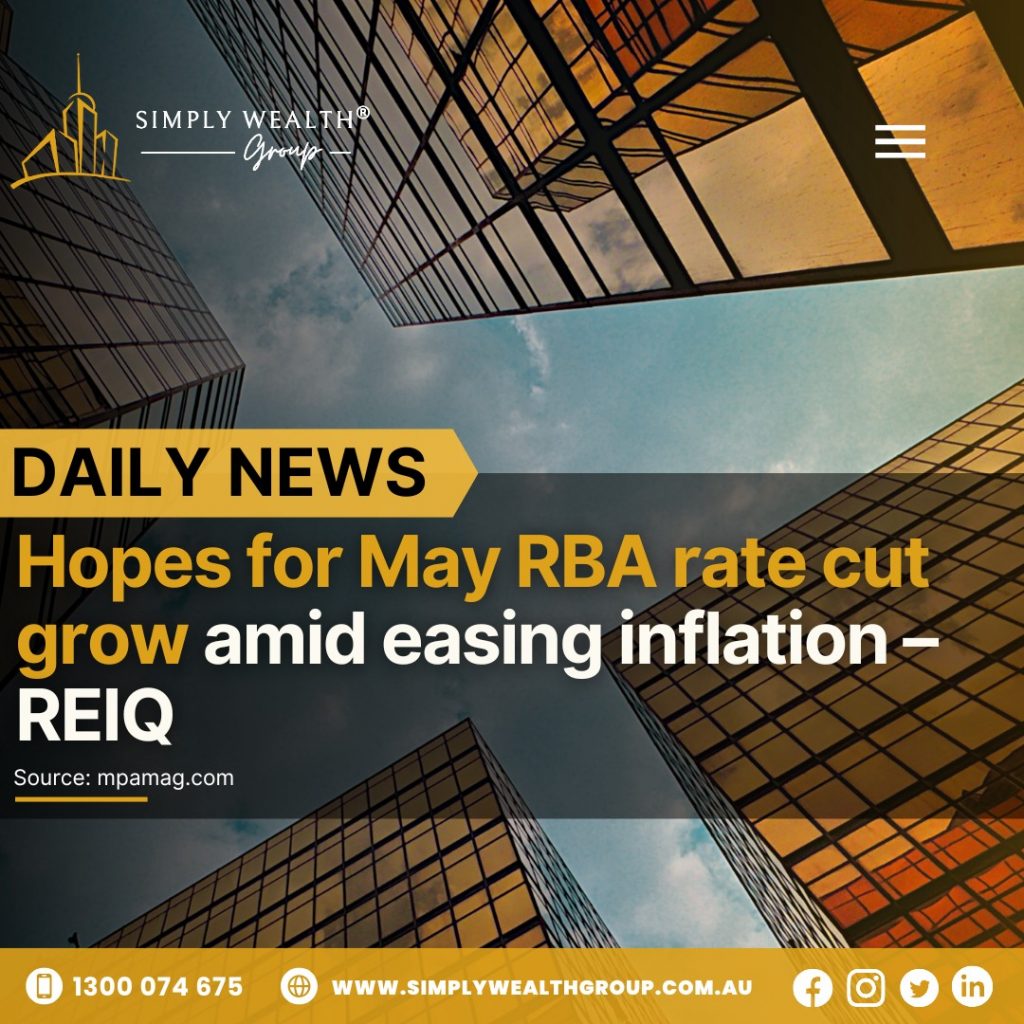
Hopes for an RBA Rate Cut in May Rise as Inflation Eases – REIQ Reports With inflation showing signs of cooling, optimism is growing for a potential Reserve Bank of Australia (RBA) rate cut in May. A reduction in the cash rate could provide significant relief to borrowers, ease mortgage stress, and bring renewed confidence to the property market. The prospect of lower interest rates is particularly encouraging for first-home buyers, investors, and homeowners looking to refinance. But how likely is an RBA rate cut, and what impact could it have on the housing market? Signs Pointing to a Possible Rate Cut The Reserve Bank of Australia has kept interest rates elevated in recent months in an effort to tame inflation, but recent economic indicators suggest that inflationary pressures are easing faster than anticipated. The latest Consumer Price Index (CPI) figures have shown a decline in price growth, particularly in sectors that previously drove inflation, such as housing, transport, and food. Key economists and market analysts are now adjusting their expectations, with many forecasting that the RBA could bring forward a rate cut to support economic growth and ease financial strain on households. What is driving this potential shift? Falling Inflation: Lower inflation figures give the RBA more flexibility to adjust rates sooner than previously expected. Slowdown in Consumer Spending: Higher borrowing costs have led to a decline in discretionary spending, indicating that monetary tightening is working. Cooling Housing Market Activity: Property prices have remained strong in many parts of Australia, but higher mortgage rates have led to reduced buyer activity, prompting calls for an adjustment. Global Economic Trends: Central banks in other major economies are also considering rate cuts, influencing expectations for Australia’s monetary policy direction. Potential Impact on Homebuyers and Investors A rate cut in May could boost market confidence and improve borrowing capacity, leading to increased demand in the property sector. Here’s how different groups may benefit: First-Home Buyers Many aspiring homeowners have struggled with affordability due to higher mortgage rates. If the RBA cuts rates, home loan repayments could become more manageable, giving first-home buyers a better chance to enter the market. Lower interest rates mean lower monthly mortgage repayments, improving affordability. Increased borrowing capacity allows buyers to consider more property options. More government incentives and grants in conjunction with lower rates could accelerate first-home purchases. Investors Property investors have taken a cautious approach in recent months due to higher financing costs. A potential rate cut could reignite investor interest, particularly in high-growth areas where rental demand remains strong. Lower mortgage rates can improve rental yields and cash flow. Increased buyer activity could push property prices higher, benefiting existing investors. More favorable lending conditions may attract new investors into the market. Homeowners and Refinancing Opportunities For existing homeowners, a rate cut could bring relief to those on variable-rate mortgages, many of whom have faced significant repayment increases over the past year. Refinancing to a lower interest rate could reduce monthly repayments. Homeowners on fixed-rate loans nearing expiration may find better deals in a lower-rate environment. Potential for increased equity growth as property values respond to renewed demand. Will Property Prices Rise if Rates Drop? Historically, lower interest rates have fueled housing price growth as borrowing becomes cheaper and demand increases. If the RBA cuts rates in May, many experts predict a stronger housing market in the latter half of 2025, with increased competition among buyers. However, the impact on property prices will depend on several factors, including: Supply levels – A shortage of housing stock could accelerate price increases. Lending policies – Banks may tighten lending conditions to prevent excessive borrowing. Economic stability – A stable job market and steady wage growth will determine buyer confidence. While some areas may experience rapid price growth, others may see a more gradual recovery. Investors and buyers will need to carefully assess local market trends before making purchasing decisions. What Should Buyers and Investors Do Now? With speculation of a rate cut in May, now is a good time to review financial plans and explore opportunities. First-home buyers should start assessing their borrowing capacity and researching suburbs with strong growth potential. Investors may want to monitor rental demand and capital growth trends, as lower rates could increase property competition. Homeowners with existing mortgages should review refinancing options and see if securing a lower rate loan is beneficial. Final Thoughts – Will the RBA Deliver a Rate Cut? While a rate cut in May is not guaranteed, the current economic indicators are increasing the likelihood of monetary policy easing sooner than later. For buyers and investors, the potential for lower rates presents an opportunity to act strategically and position themselves for a more favorable lending environment. With the property market expected to react swiftly, staying informed and prepared will be crucial in making the right investment or purchasing decision. Want to stay ahead of the latest property trends? 📖 Read more here: https://tinyurl.com/nvb7y99r📞 Need property insights? Call us at 1300 074 675🌐 Visit us: simplywealthgroup.com.au📱 Follow us: @SimplyWealthGroup for expert property insights and updates.
Australian Home Prices See an Uptick After February Rate Cut – What It Means for Buyers & Investors!
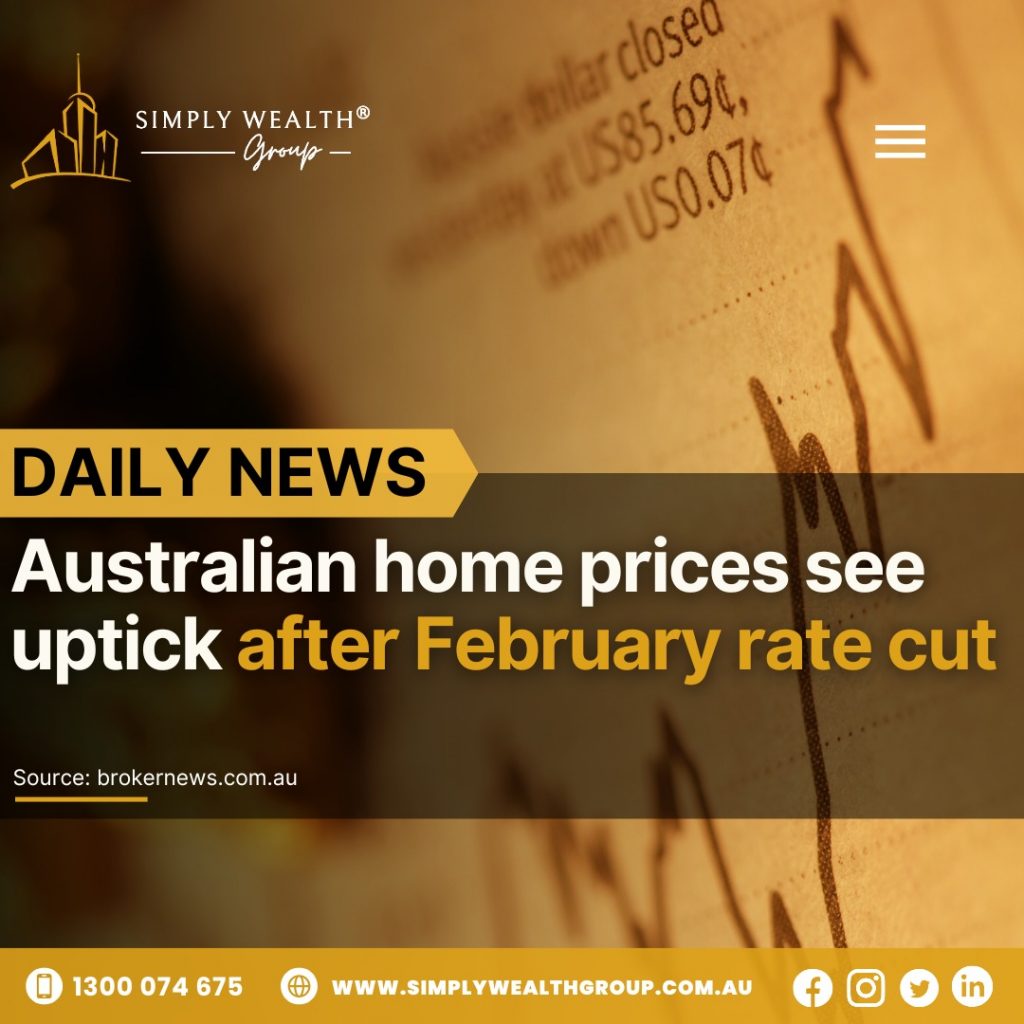
Australian Home Prices See an Uptick After February Rate Cut – What It Means for Buyers & Investors The Australian housing market is witnessing a noticeable uptick in home prices following the Reserve Bank of Australia’s (RBA) interest rate cut in February. With borrowing costs easing, confidence among buyers and investors has surged, leading to heightened demand and rising property values. For first-home buyers, homeowners, and investors, understanding these market shifts is crucial for making informed financial decisions. But what exactly is driving this surge, and how should you navigate the evolving landscape? Why Are Home Prices Increasing? Several factors are contributing to the recent upward trend in property prices. Let’s break down the key drivers: Lower Interest Rates = More Affordable Home Loans The February rate cut has directly impacted mortgage repayments, making home loans more affordable. Lower borrowing costs allow buyers to secure larger loan amounts, increasing their purchasing power and driving more activity in the market. Banks and lenders have also responded by offering competitive mortgage deals, further enticing buyers to take the plunge into homeownership. Increased Buyer Competition As borrowing becomes more affordable, more buyers are entering the market. This surge in demand, particularly in high-growth suburbs, is leading to increased competition at auctions and private sales. Properties in desirable areas are now selling faster, and some are even attracting multiple offers, further pushing up prices. Investors Returning to the Market With improved affordability and the potential for capital gains, property investors are returning in full force. Many are seeing this as an opportunity to secure investment properties before prices rise even further. Rental demand remains strong, making investment properties an attractive option for those looking for stable long-term returns. FOMO (Fear of Missing Out) Effect Market psychology plays a big role in price movements. With headlines highlighting rising prices and increased competition, many buyers fear missing out on good deals. This sentiment is driving even more people into the market, adding further momentum to property value growth. What This Means for First-Home Buyers For first-home buyers, the recent price increases mean that waiting could result in higher costs. As home values continue to climb, securing a property sooner rather than later might be a wise move. Additionally, government incentives, such as First Home Buyer Grants and stamp duty concessions, are still available in many states. These incentives can help ease the financial burden of purchasing a home and should be factored into your decision-making process. The key for first-home buyers is to act strategically—research high-growth areas, explore financing options, and get pre-approved for a mortgage before jumping into the market. The Outlook for Property Investors For property investors, this market shift signals a strong opportunity for long-term growth. With increasing home values, steady rental demand, and lower interest rates, now could be the right time to expand property portfolios. Investors should consider:🔹 Emerging suburbs with growth potential🔹 New developments that qualify for tax incentives🔹 High-rental-yield areas to maximize cash flow A key strategy is to focus on properties with long-term capital appreciation while ensuring a strong rental return in the short term. What’s Next for the Property Market? The big question: How high will home prices go? Market analysts have mixed predictions. Some forecast moderate price growth, while others anticipate a sustained rise due to continued buyer demand and limited housing supply. Key factors to watch include:🏦 Future RBA interest rate decisions🏗 Housing supply levels in major cities📉 Economic trends impacting buyer sentiment If additional rate cuts occur, demand could increase further, pushing home prices even higher. However, unexpected global economic shifts could also introduce volatility into the market. Should You Buy Now or Wait? With property prices trending upward, waiting could mean paying more. Whether you’re a first-home buyer or an investor, the current market presents opportunities—but only for those who act decisively. 📖 Read the full market update here: https://tinyurl.com/2w8rptn3 📞 Ready to take advantage of these changes? Let’s talk! Call us at 1300 074 675🌐 Visit: simplywealthgroup.com.au 📱 Stay ahead with the latest property insights—follow @SimplyWealthGroup for expert tips!
Breaking News: Australia’s Non-Resident Buying Ban Takes Effect Today!
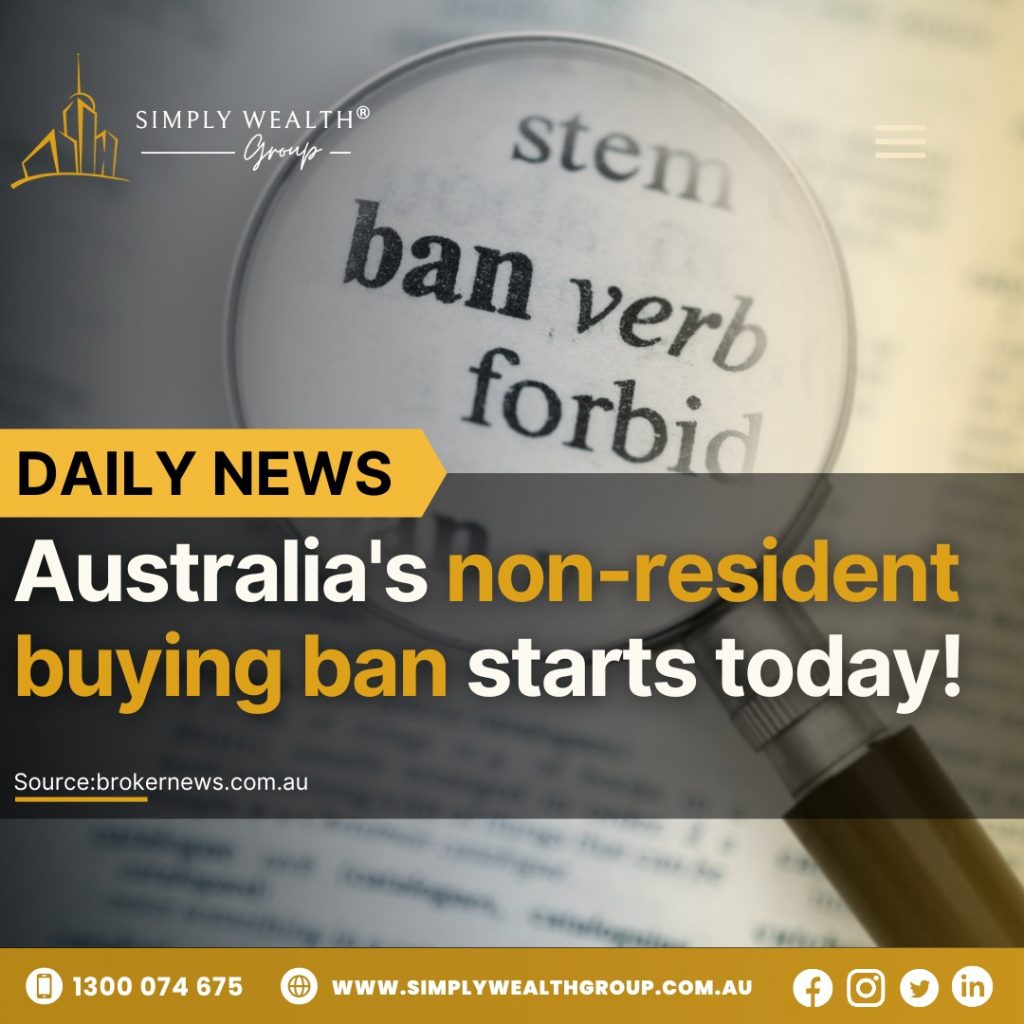
Breaking News: Australia’s Non-Resident Buying Ban Takes Effect Today Big changes are underway in the Australian property market! As of today, non-residents are officially banned from purchasing existing homes in Australia. This significant policy shift, aimed at easing housing affordability pressures, is expected to reshape the real estate landscape by increasing opportunities for local buyers and cooling down excessive foreign demand. Why the Ban? With soaring property prices making homeownership increasingly out of reach for many Australians, the government has introduced this measure to prioritize local buyers. Foreign investors have historically been attracted to Australia’s robust real estate market, leading to increased competition and, in some cases, price inflation in key urban centers. By restricting non-resident purchases, policymakers hope to create a more balanced and accessible market for Australian residents, particularly first-home buyers. Impact on the Housing Market For First-Home Buyers This ban could be a game-changer for Australians struggling to enter the property market. With reduced competition from foreign investors, housing prices may stabilize or even decrease in certain areas, allowing first-home buyers better access to properties that were previously out of reach. For years, many young Australians and families have faced bidding wars against cashed-up international buyers, especially in Sydney and Melbourne. The restriction on non-residents purchasing existing homes means that local buyers now stand a better chance of securing homes at more affordable prices. For Investors While the ban might reduce speculative foreign demand, local and resident investors will continue to play a significant role in the market. The shift may also encourage greater investment in new housing developments, as non-residents will still be permitted to buy newly built properties. This could lead to increased construction activity and more housing supply, benefiting renters and buyers alike. Some experts suggest that the rental market may experience slight fluctuations as fewer foreign investors purchase properties to lease out. However, long-term local investors may see more opportunities to expand their portfolios without facing as much competition from overseas buyers. For Property Prices Experts predict that while the immediate effect of the ban may lead to a slight dip in prices, the long-term impact will depend on various factors, including interest rates, economic conditions, and housing supply levels. High-demand areas, particularly in major cities like Sydney and Melbourne, may see slower price growth, giving local buyers a better chance at securing properties. Some regional and suburban areas that have attracted significant international investment in the past may experience short-term price corrections, while others may see sustained demand driven by local buyers and interstate migration. Exceptions and Loopholes While the ban applies to existing homes, foreign investors can still purchase new developments or off-the-plan properties. This is intended to encourage new housing supply, which remains a critical issue in Australia’s growing cities. Additionally, temporary residents in Australia may still buy property under specific conditions, but they will need to seek approval from the Foreign Investment Review Board (FIRB). What Should Buyers and Investors Do Now? For First-Home Buyers: Now is the time to reassess your buying strategy. With less foreign competition, explore opportunities in areas that previously had high investor demand. Research suburbs with strong infrastructure growth, transport links, and lifestyle amenities that may now be more accessible. For Investors: Consider diversifying into new developments or emerging suburbs where demand remains strong. Look at rental yields and growth potential to make informed decisions. With government incentives available for new housing developments, investors may find lucrative opportunities in upcoming projects. For Sellers: If you were relying on foreign buyers, consider adjusting pricing strategies or targeting local demand. Marketing efforts should now focus on appealing to domestic buyers and emphasizing affordability, lifestyle benefits, and long-term investment potential. Stay Informed and Make Smart Moves The real estate market is always evolving, and policy changes like this can create both challenges and opportunities. Whether you’re looking to buy, sell, or invest, staying informed is crucial. 📚 Read the full article to learn more: https://tinyurl.com/3yffrdx8 📞 Need expert guidance? Call us at 1300 074 675 🌐 Visit: simplywealthgroup.com.au 📱 Follow @SimplyWealthGroup for real-time market updates!
RBA Rate Cut: A Win for Borrowers & a Surge in Loan Applications!

RBA Rate Cut: A Win for Borrowers & a Surge in Loan Applications! RBA Rate Cut: A Win for Borrowers & a Surge in Loan Applications! Australia’s property market just received a significant boost! With the Reserve Bank of Australia (RBA) cutting interest rates, mortgage stress is easing, and borrowers are seizing the opportunity to secure better deals. Lower repayments mean increased borrowing power, leading to a surge in home loan applications across the country. Whether you’re a first-home buyer, an investor, or looking to refinance, this shift in the lending landscape presents a golden opportunity. What Does This Rate Cut Mean for You? The RBA’s decision to lower interest rates is designed to stimulate economic activity by making borrowing cheaper and more accessible. This move has immediate and long-term benefits for different types of borrowers: ✅ Lower Repayments: A reduced interest rate means that homeowners will pay less on their monthly mortgage, easing financial pressure and allowing for increased discretionary spending. 💰🏡 ✅ Increased Borrowing Power: Lower rates enable borrowers to qualify for larger loans, providing an opportunity to purchase higher-value properties or invest in multiple assets. 📈🏠 ✅ Surge in Loan Applications: As more Australians recognize the opportunity to secure competitive home loan rates, banks and mortgage brokers are seeing a significant increase in loan inquiries. 📑💡 ✅ Refinancing Boom: Homeowners and investors are refinancing their existing loans to lock in better interest rates, reducing their overall interest burden and securing long-term savings. 🔄💲 ✅ First-Home Buyers Stepping Up: With improved affordability and government incentives, many first-time buyers are finding it easier to enter the property market. 🏡✨ A Surge in Home Loan Applications Financial institutions across the country are already experiencing a significant uptick in loan applications. Borrowers, eager to take advantage of historically low rates, are making moves before further market shifts. The combination of lower interest rates, increased consumer confidence, and favorable lending conditions is leading to heightened activity in both the owner-occupier and investment property sectors. Refinancing: The Smart Move for Homeowners With rates dropping, many existing mortgage holders are re-evaluating their current loans. Refinancing can lead to substantial savings, offering homeowners a chance to: 🔄 Reduce Monthly Repayments – Lower interest rates translate to lower monthly payments, freeing up cash for savings, investments, or lifestyle expenses. 🔄 Consolidate Debt – By rolling high-interest debts (such as credit cards and personal loans) into a refinanced home loan, borrowers can enjoy lower interest rates and streamlined repayments. 🔄 Access Home Equity – Property owners with built-up equity can use refinancing to unlock funds for renovations, investments, or personal projects. Investor Market on the Rise Property investors are also taking advantage of the rate cut, with many looking to expand their portfolios. The combination of lower borrowing costs, strong rental demand, and long-term capital growth potential makes this an ideal time for investors to: ✔ Secure Investment Loans – With banks offering more competitive rates, investors can lock in favorable financing terms. ✔ Expand Property Portfolios – Lower repayments mean higher potential returns, making investment properties more attractive. ✔ Leverage Equity for New Purchases – Investors can use their existing properties as leverage to acquire additional real estate. How Will the Market React? The property market is expected to respond positively to the rate cut. Historically, lower interest rates have led to increased buyer demand, higher auction clearance rates, and steady property price growth. However, the window of opportunity may be limited, as demand often leads to price increases. Acting now could mean securing a better deal before the market shifts further. Is Now the Right Time to Buy, Invest, or Refinance? With historically low interest rates, attractive lending conditions, and a competitive property market, this could be the perfect time to make your move. Whether you’re looking to purchase your first home, upgrade your existing property, invest in real estate, or refinance for better terms, the current market dynamics favor proactive buyers. 🔎 Read more here: https://tinyurl.com/m5z5pbj 📞 Need expert guidance? Call us at 1300 074 675 🌐 Visit: simplywealthgroup.com.au 📱 Follow us for the latest property insights: Instagram & Facebook @SimplyWealthGroup 🏡 Take action today—maximize your opportunities in this changing market
Australian Household Wealth Sees Modest Growth in Q4 2024 Despite Falling House Prices
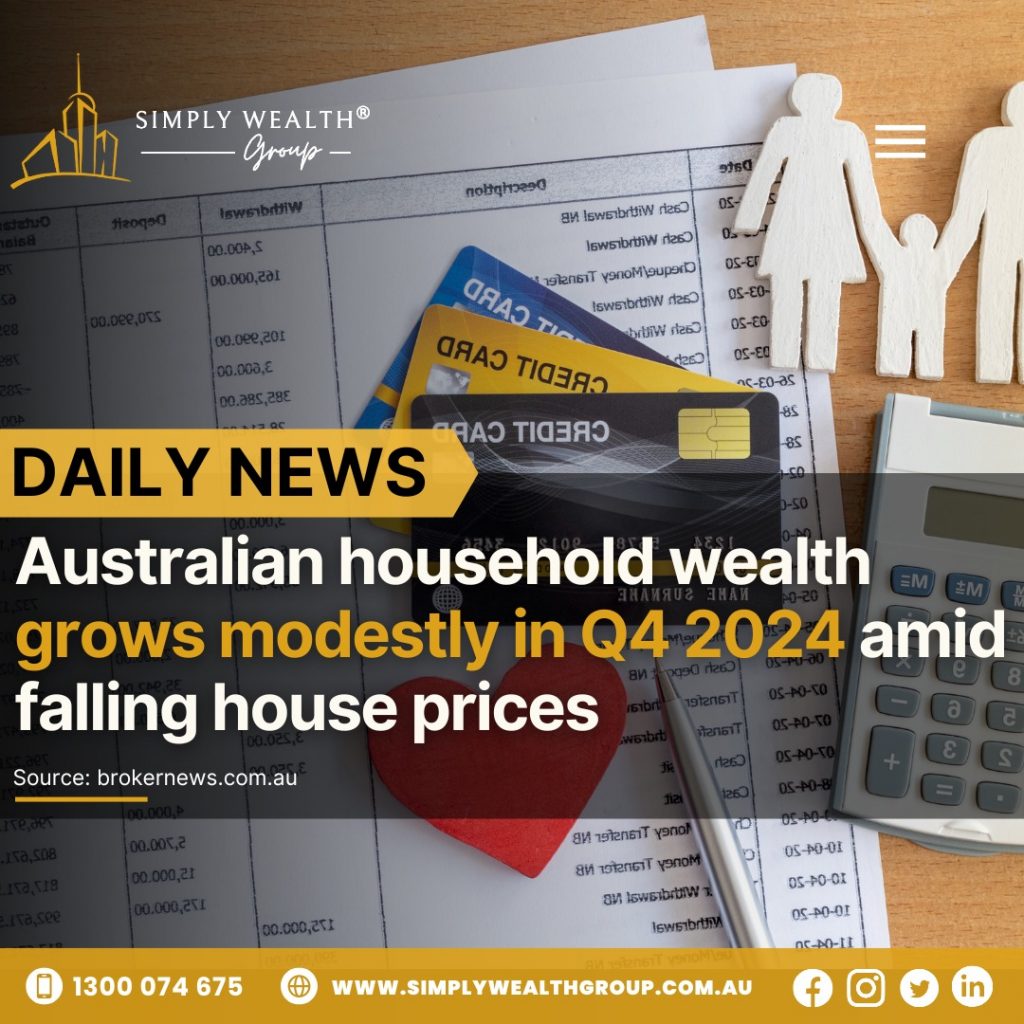
📊 Australian Household Wealth Sees Modest Growth in Q4 2024 Despite Falling House Prices 🏡📉 While property prices softened in late 2024, Australia’s household wealth continued to grow, fueled by superannuation gains and stock market resilience. According to the latest Australian Bureau of Statistics (ABS) report, household net worth increased by 0.8%, highlighting investment stability amid a shifting real estate landscape. 🔎 Key Insights from Q4 2024 Market Trends 📈 Superannuation & Stock Market Gains – Rising equity markets bolstered retirement savings, helping offset real estate declines. 🏡 Property Market Adjustments – While some regions saw price dips, this presents unique buying opportunities for first-home buyers and investors. 💰 Debt vs. Savings Balancing Act – With interest rates still relatively high, many mortgage holders are prioritizing financial security and savings growth. 📊 Investor Outlook – A Stabilizing Market – While the market fluctuates, long-term investors can benefit from strategic property acquisitions in emerging high-growth areas. 💡 What This Means for You 🔹 For First-Home Buyers: Recent property price corrections could open the door for more affordable homeownership options. If you’ve been waiting for the right time to enter the market, this could be it! 🔹 For Investors: The short-term cooling in property prices offers a window of opportunity to acquire assets before the next growth cycle kicks in. Pair this with diversified investment strategies for long-term gains. 🔹 For Homeowners & Mortgage Holders: With market fluctuations, it’s crucial to review your mortgage and refinance options to ensure you’re maximizing your financial position amid changing interest rate environments. 🏡 Now’s the Time to Take Action! The market is evolving—how will you position yourself for success? Whether you’re a first-home buyer, seasoned investor, or looking to refinance, making informed decisions today could shape your financial future. 📢 Our team at SimplyWealth Group is here to help! Get expert insights, tailored investment strategies, and financial guidance to navigate Australia’s dynamic property market. 📞 Call us today: 1300 074 675📲 WhatsApp: +61 488 859 637🌐 Visit us: simplywealthgroup.com.au 📱 Follow us for market insights & updates!🔹 Instagram: @SimplyWealthGroup🔹 Facebook: Simply Wealth Group🔹 Twitter: @SimplyWealthGrp ⏳ Opportunities won’t wait—start planning your next move today! 🚀
Westpac Predicts RBA to Hold Rates Steady in April
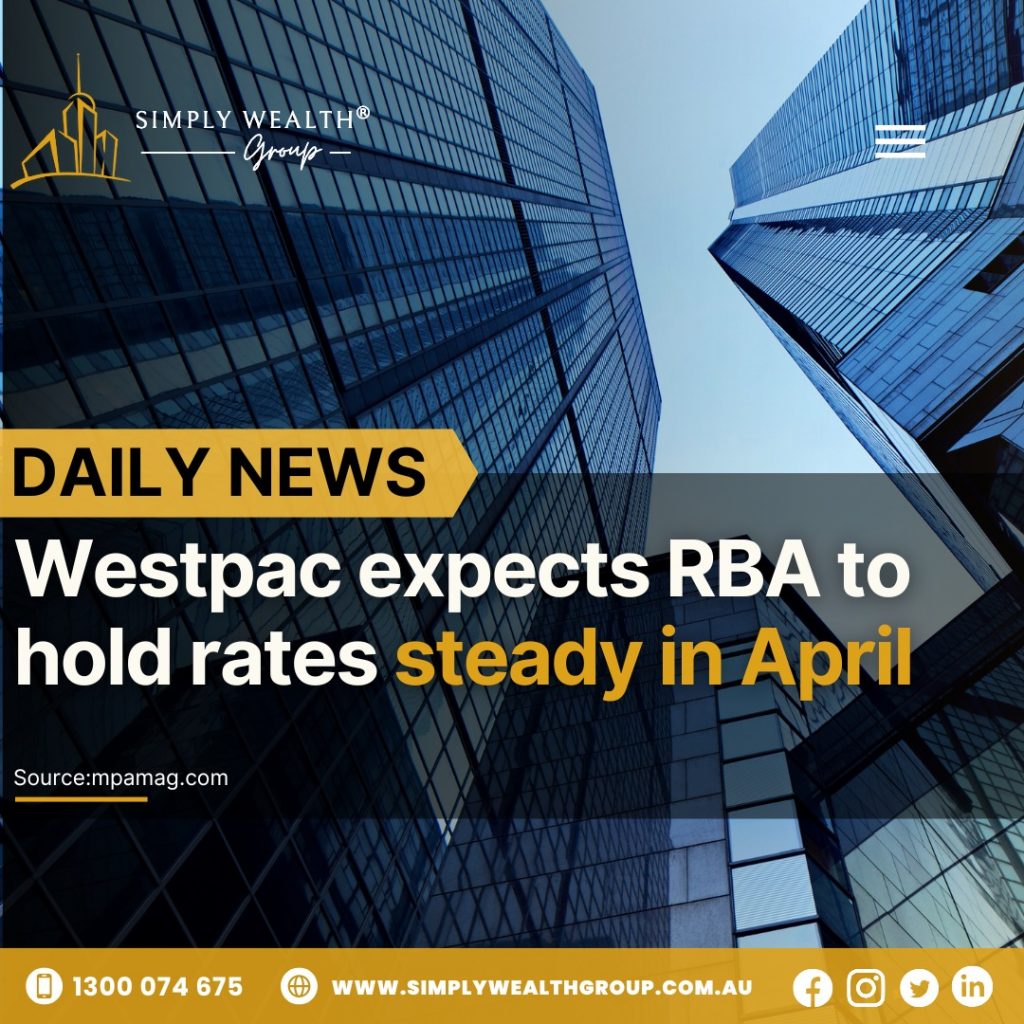
Westpac Predicts RBA to Hold Rates Steady in April Westpac Predicts RBA to Hold Rates Steady in April Amid Economic Uncertainty As the Reserve Bank of Australia (RBA) gears up for its April 1 meeting, leading analysts at Westpac anticipate that the central bank will maintain the official cash rate at its current level. While there has been increasing speculation regarding potential interest rate cuts later in 2025, the RBA appears to be exercising a cautious, data-driven approach before making any policy adjustments. Key Factors Influencing the RBA’s Decision Westpac’s forecast is based on several critical economic indicators, including: 🔹 Inflationary Pressures – Although inflation has eased from its peak in 2022, core inflation remains above the RBA’s target range. The central bank remains focused on ensuring inflation returns to sustainable levels before considering rate reductions. 🔹 Resilient Labour Market – Australia’s unemployment rate remains historically low, signaling a strong job market. With wage growth stabilizing, the RBA sees no immediate pressure to lower rates in an effort to stimulate employment. 🔹 Global Economic Trends – The RBA is closely monitoring international economic developments, particularly in the United States and China, as shifts in global markets could influence Australia’s economic stability. Implications for Borrowers, Investors & the Housing Market 📌 Mortgage Holders & Homebuyers – With no immediate rate cuts, borrowing costs will remain steady for now. However, potential reductions later in 2025 could provide relief for mortgage holders and prospective buyers. 📌 Property Investors – The real estate market remains active, driven by strong demand and increasing investor participation. Now may be an opportune time to explore property investments before financing conditions potentially shift. 📌 Refinancing Opportunities – Homeowners with existing loans may want to reassess their mortgage terms, considering the possibility of securing competitive rates before the market adjusts. What’s Next? While Westpac continues to forecast rate cuts later in 2025, the bank emphasizes that the RBA will only act when inflation is firmly under control. Until then, borrowers and investors should stay proactive in monitoring market conditions and consider strategic financial planning to navigate the evolving economic landscape. 📞 Seeking expert property and investment guidance? Contact Simply Wealth Group today!📲 Call us: 1300 074 675🌐 Visit: simplywealthgroup.com.au📱 Follow us for market insights & updates: @SimplyWealthGroup
Record Investor Loan Growth Across Australian States!

🏡 Investor Loans Surge as Market Heats Up – Are You Ready to Capitalize? 📈🔥 Australia’s property investment market is booming, with the latest Mortgage Insights from Money.com.au revealing a 22% surge in investor loans over the past year! This growth far outpaces the 6% rise in owner-occupier loans, signaling renewed confidence and strong demand in the investment sector. 📊 Market Snapshot:🏠 Investor Loans: 192,843 new approvals (up 22% YoY)🏡 Owner-Occupier Loans: 322,273 approvals (up 6% YoY) Read more here: https://tinyurl.com/mryuaaxx 💡 What’s Fueling the Investor Boom? ✔️ Increased Borrowing Power – The Reserve Bank’s first OCR cut since 2020 has created favorable lending conditions, allowing investors to secure better rates and higher borrowing capacity. 💰📉✔️ Market Confidence is Back – With interest rate relief, buyers are making their moves, leading to higher auction clearance rates, rising property values, and increased competition. 🏡📈✔️ Attractive Rental Yields – Investors are seizing the opportunity to maximize returns, with rising rents, low vacancy rates, and long-term capital growth potential. 📊💵✔️ Demand for Investment Properties is Soaring – With strong population growth, limited housing supply, and increasing rental demand, investors are locking in high-growth opportunities before prices rise further! 🚀🏠 📢 Why Now Is the Best Time to Invest? ⏳ Market conditions are shifting in favor of investors—waiting could mean paying more later!💸 Secure a property at today’s prices before competition intensifies.🏠 Leverage lower interest rates for better cash flow and long-term gains.💰 Maximize your portfolio’s growth potential in Australia’s thriving property market! 🔥 Ready to Seize the Opportunity? Let’s Talk! 📞 Call Our Expert Team: 1300 074 675📲 WhatsApp: +61 488 859 637🌐 Visit Our Website: simplywealthgroup.com.au 📱 Stay Updated with the Latest Property Investment Insights:🔹 Instagram: @SimplyWealthGroup🔹 Facebook: Simply Wealth Group 🚀 Don’t Miss Out – The Best Time to Invest is NOW! 🔑🏡
ANZ & Macquarie Slash Fixed Home Loan Rates Ahead of RBA Decision!

🏡 ANZ & Macquarie Slash Fixed Home Loan Rates – What This Means for You! 📉💰 Great news for homebuyers, investors, and refinancers! Two of Australia’s biggest lenders, ANZ and Macquarie, have just announced significant reductions in their fixed home loan rates—just days ahead of the Reserve Bank of Australia’s (RBA) upcoming cash rate decision. 💰 With rates dropping and potential further cuts on the horizon, this could be the golden opportunity you’ve been waiting for! 🔥 Key Rate Cuts at a Glance: 🏦 ANZ:✅ One-year fixed rates reduced by 0.25% for owner-occupiers✅ 0.15% cut for investors making principal & interest repayments✅ First fixed rate reduction by ANZ since October 2024 🏦 Macquarie Bank:✅ One-year fixed rate down 0.20%✅ Two- & three-year terms cut by 0.16%✅ Four- & five-year rates reduced by 0.10%✅ Macquarie remains the fifth-largest home loan lender in Australia 🔗 Read More: https://tinyurl.com/yc8yk74s 💡 What Does This Mean for You? These reductions could signal a broader trend of falling interest rates, presenting new opportunities for: ✔ Homebuyers – Lower fixed rates mean more affordable repayments, making it easier to get into the market. 🏠✔ Investors – Secure better financing options, improve cash flow, and maximize long-term returns. 📈✔ Refinancers – If you have a high-rate mortgage, now is the time to explore refinancing and lock in a lower rate! 🔄✔ Market Confidence – Banks cutting rates ahead of the RBA’s decision suggests optimism in market stability, giving buyers more confidence to act now. 🚀 ⏳ Why Act Now? 🏡 Interest rates are shifting, and early movers benefit the most!📉 Lock in a lower fixed rate before further market changes.📊 Lenders are competing for borrowers, making this the perfect time to negotiate better terms! 📣 Don’t Miss Out – Secure the Best Deal Today! 📞 Call Our Team: 1300 074 675🌐 Explore Your Loan Options: simplywealthgroup.com.au 📱 Stay Ahead with Property & Finance Updates:🔹 Instagram: @SimplyWealthGroup🔹 Facebook: Simply Wealth Group 🚀 Get in Touch & Lock in a Great Rate Before the Market Shifts!

